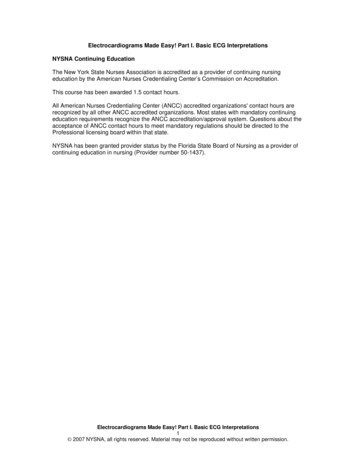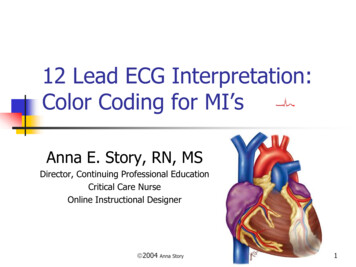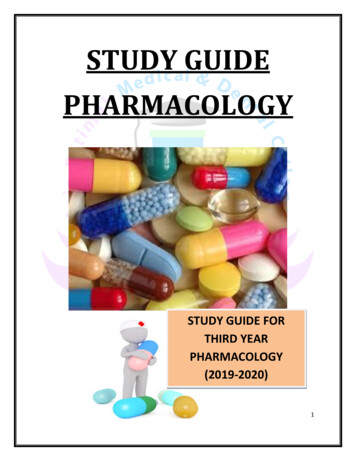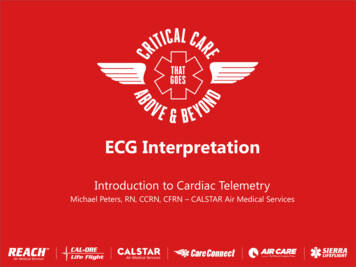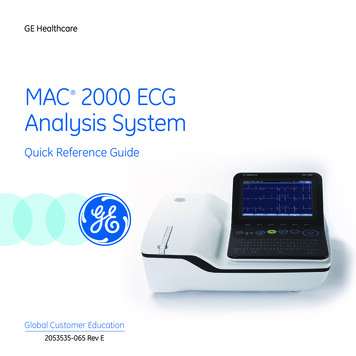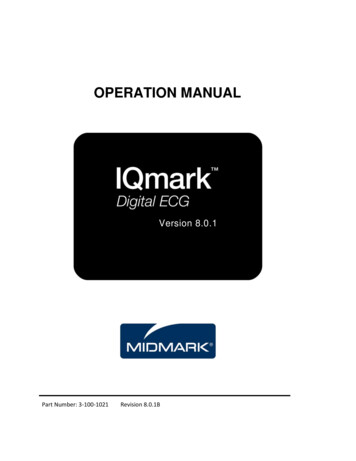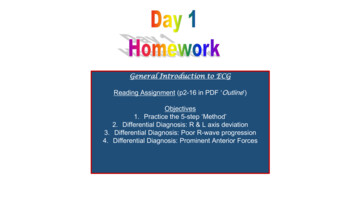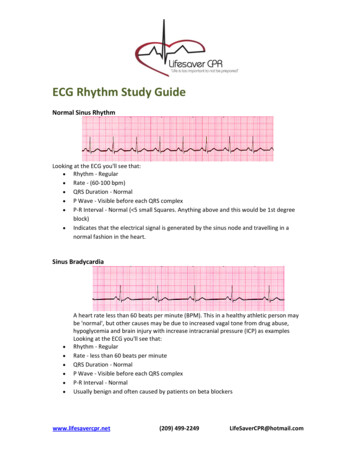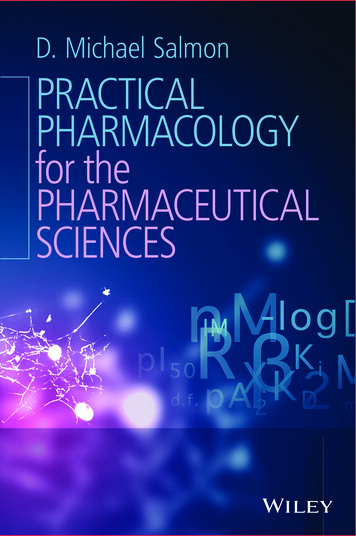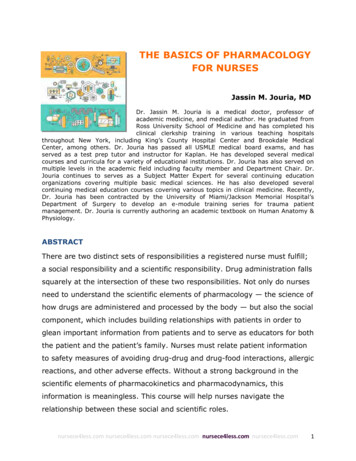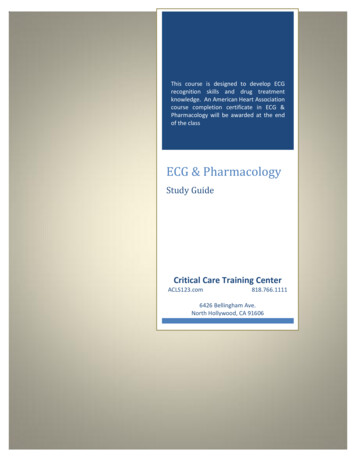
Transcription
This course is designed to develop ECGrecognition skills and drug treatmentknowledge. An American Heart Associationcourse completion certificate in ECG &Pharmacology will be awarded at the endof the classECG & PharmacologyStudy GuideCritical Care Training CenterACLS123.com818.766.11116426 Bellingham Ave.North Hollywood, CA 91606[Type text]Page 0
Cardiac ArrhythmiasPulseless RhythmsVentricular FibrillationVentricular Fibrillation (V-Fib or VF) is the most common rhythm that occurs immediately after cardiacarrest. In this rhythm, the ventricles quiver and are unable to uniformly contract to pump blood. It isfor this reason that early defibrillation is so imperative. A victim’s chance of survival diminishes rapidlyover time once the heart goes into V-Fib; therefore, each minute counts when initiating defibrillation.When defibrillating, heart stops hopingthat the heart is viable for normal pacemaker to initiate a rhythm.There are two types of VF, fine and course. Course VF usually occurs immediately after a cardiac arrestand has a better prognosis with defibrillation. Fine VF has waves that are nearly flat and look similar toasystole. Fine VF often develops after more prolonged cardiac arrest and is much more difficult tocorrect.Course VFFine VFVentricular Tachycardia Stable vs UnstablePulse vs No PulseVentricular Tachycardia (VT) can present itself with or without a pulse. When a VT is present and thevictim has no pulse, the treatment is the same as the VF. High dose shocks for defibrillation will give thebest chance for converting the patient out of pulseless VT.Critical Care Training CenterACLS123.com818.766.1111Page 1
Pulseless Electrical ActivityPulseless Electrical Activity (PEA) occurs when the heart is beating and has a rhythm, it can be anyrhythm, but the patient does not have a pulse. Always treat the patient, not the rhythm. HypovolemiaHypoxiaHydrogen ion (acidosis)Hypo-/hyperkalemiaHypothermiaTension pneumothoraxTamponade, cardiacToxinsThrombosis, pulmonaryThrombosis, coronary1. Problem or Possible correctable causes (H’s & T’s)2. Epinephrine 1mg 1:10,000 – give to anyoneWITHOUT a pulseIn order to treat pulseless rhythm, bradycardia, ortachycardia, identification of the possible underlyingcauses is essential.AsystoleAsystole is when there is no detectable cardiac activity on EKG. It may occur immediately after cardiacarrest or may follow VF or PEA. Asystole may also follow a third degree heart block. Treatment ofasystole is the same as PEA. The American Heart Association recommends that if a patient is insustained Asystole for 15 minutes, it is reasonable to call the code, but involve the family in the decisionif they are available.Critical Care Training CenterACLS123.com818.766.1111Page 2
Rhythms with Pulse – Bradycardia & BlocksBradycardiaBradycardia occurs when the heart is beating too slow ( 50 beats per minute). If symptomatic, provideoxygen, given Atropine 0.5mg up to 3mg and call for the transcutaneous pacemaker.In Sinus Bradycadia, the SA node fires at a rate slower than normal for a person’s age. Athletes mayhave heart rates less than 50 due to their physical conditioning. Obviously, they would not needtreatment. It is possible for patient to have a heart rate of 50 and be asymptomatic; however, if apatient with a heart rate of less than 50 has signs of poor perfusion, begin treatment with oxygen andAtropine 0.5mgFirst-Degree AV Block – ALL P WAVES CONDUCTED BUT DELAYEDFirst-Degree AV Block prolonged PR interval ( 0.20 seconds or 5 small boxes on the ECG strip)In the first-degree AV block, all of the components of the ECG strip are normal except the PR interval.What happens in this situation is that the impulse from the SA node is delayed at the AV node. Allimpulses are, however, conducted following the delay.Critical Care Training CenterACLS123.com818.766.1111Page 3
Second-Degree AV Block Type I, (Mobitz I, Wenckebach) – Some P waves conducted, others blockedSecond-degree AV block type I (Mobitz I, or Wenckeback) progressive lengthening of the PR intervalwith dropped QRS complexes.The delay in Second-degree AV block type I also occurs at the AV node. The delay, resulting inprogressively lengthening PR interval and then there will be a P wave that is not followed by a QRScomplex. Following this event, the cycle starts over again with progressively lengthening PR intervalfollowed by a dropped QRS.Each repeating Wenckebach series has a consistent P:QRS ratio with one less QRS than Ps in the series.Block location differentiates second degree AV Type I block from Type II blocks.Second-Degree AV Block Type II (Mobitz II) – Some P waves conducted, other blockedSecond-degree AV block type II PR interval stays the same, but there are dropped QRS complexes.The delay in second-degree AV block type II occurs below the AV node at the Bundle of His or bundlebranches. They usually produce a series of cycles consisting of one normal P-QRS-T cycle preceded by aseries of paced P waves that fail to conduct through the AV node resulting in no QRS. This is a muchmore serious rhythm than Wenckebach and transcutaneous pacing is usually recommended.Critical Care Training CenterACLS123.com818.766.1111Page 4
Third Degree or Complete AV BlockThird Degree or Complete AV Block no communication in the heart between SA and AV node.In third-degree or complete AV block, the impulse originating in the SA node is completely blocked. Thisblock may occur at the AV node, bundle of His or bundle branches. In response to this situation, theheart may develop a second pacemaker (either junctional or ventricular) in order to stimulate theventricles to contract. The location of this “escape pacemaker” will determine if the QRS complexes arewide or narrow. A junctional (narrow QRS complex) escape pacemaker rhythm may possible be stablewith a ventricular rate of more than 40 bpm. However, a ventricular (wide QRS complex) escapepacemaker rhythm is usually unstable with a heart rate of less than 40 bpm.Often heart blocks occur due to cardiac damage following an MI. In high degree blocks (type II andthird-degree AV block), characterized by poor perfusion, Atropine 0.5 mg may be given, but prepare fortranscutaneous pacing that may be required.Rhythms with Pulse - TachycardiaThere are three basic groups of tachycardias: sinus tachycardia, supraventricular tachycardia (includingatrial tachycardia) and ventricular tachycardia. Fortunately, there is only one algorithm to treat all ofthem. They key factors are: STABLE vs. UNSTABLE and PULSE vs. NO PULSE. Additional factors areNARROW QRS vs. WIDE QRS and REGULAR vs. IRREGUAR.Critical Care Training CenterACLS123.com818.766.1111Page 5
Sinus TachycardiaSinus tachycardia occurs when the SA node is firing at a rate that is faster than normal for a person’sage. The rate is generally 101 to 150 bmp. The key to sinus tachycardia is that all components of anormal ECG are present, P wave, QRS complexes, and T wave. Sinus tachycardia generally starts andstops gradually. There is often a cause such as pain, fever, or agitation that can be identified andtreated.Supraventricular TachycardiaSupraventricular Tachycardia (SVT) includes any rhythm that begins above the bundle braches. Thisincludes rhythm that begins in the SA node, atrial tissue, or the AV junction. Since the rhythms arisefrom above the bundle branches, they are characterized by narrow QRS complexes. A supraventriculartachycardia is not the name of a specific arrhythmia. It is a term used to describe a category of regulararrhythmias that cannot be identified more accurately because they have indistinguishable P waves dueto their fast rate – usually greater than 150 bpm. The P waves are often indistinguishable because theyrun into the preceding T waves. The most common SVT rhythms are atrial tachycardia and junctionaltachycardia, although Sinus Tachycardia and Atrial Flutter can sometimes also fit into their category withindistinguishable P waves.Critical Care Training CenterACLS123.com818.766.1111Page 6
SVT TreatmentTreatment Question #1 – Stable vs. UnstableIf Unstable – CardiovertIf Stable, answer question #2Treatment Questions #2 – Regular vs. IrregularRhythmRegular (SVT or Junctional) Vagal maneuversAdenosine (1st dose 6mg)Adenosine (2nd dose 12mg)Irregular (A-Fib, A-Flutter, Multi-focal A-Tach) Calcium Channel Blockers or Beta BlockersA A-fib, A-FlutterB Beta BlockersC Calcium Channel Blockers (usually used 1st toslow the rate)Critical Care Training CenterACLS123.com818.766.1111Page 7
This course is designed to develop ECG recognition skills and drug treatment knowledge. An American Heart Association course completion certificate in ECG & Pharmacology will be awarded at the end of the class ECG & Pharmacology Study Guide Critical Care Trai

